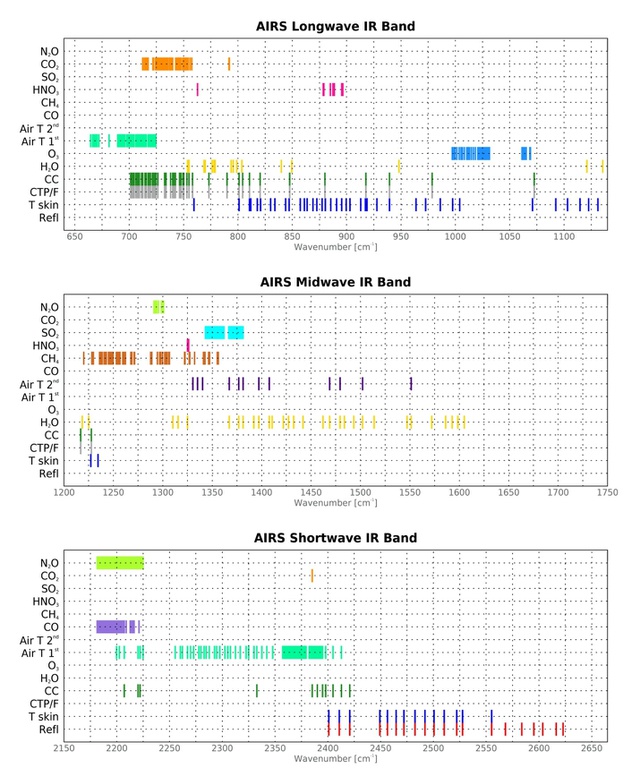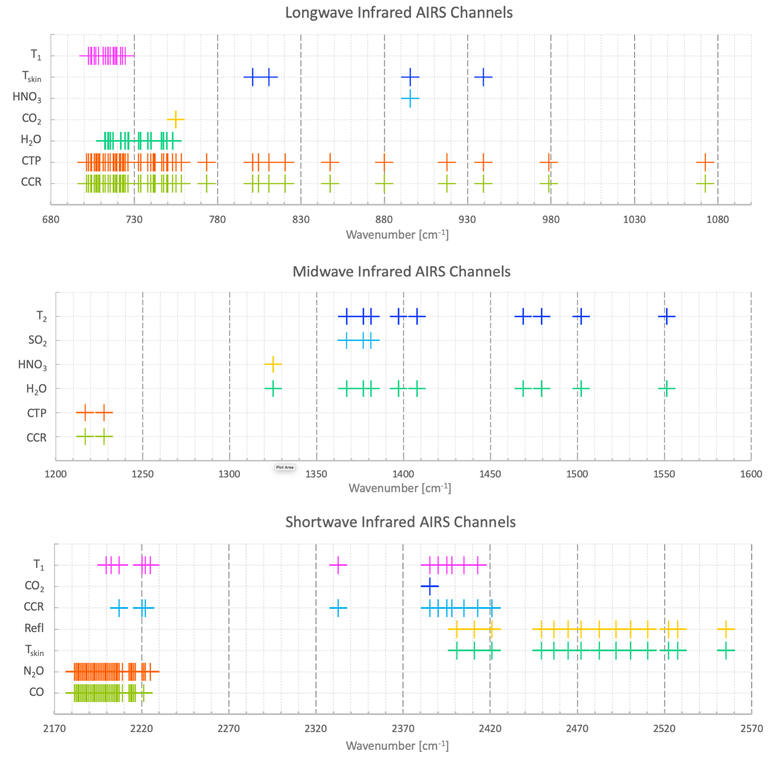Channel subsets for AIRS and CrIS
1. Overview
CLIMCAPS uses subsets of channels to retrieve atmospheric variables one at a time in a sequence as depicted in the flow-diagram. These subsets of channels, each an order of magnitude lower than the total number of channels, significantly reduces retrieval execution time.
CLIMCAPS retrieves the full set of atmospheric state variables within ~150 ms per cloud-cleared scene, or 6 min for a 6 min Level 1b granule. The number of channels we select for each variable depends on the measurement signal-to-noise and degree of interference from other variables.
In Section 2 we depict the IR channel subsets for each retrieval variable and each instrument configuration – AIRS, CrIS nominal spectral resolution (CrISNSR) and CrIS full spectral resolution (CrISFSR). The CLIMCAPS IR channel selection methodology is detailed elsewhere (Gambacorta and Barnet, 2011, 2013) and we briefly outline it in Section 3 below.
The channel sets we present here is for CLIMCAPS V2 and can easily be changed or updated in future versions as we improve the system across instruments. The channel lists are defined in FORTRAN namelists, not in the source code itself.
2. CLIMCAPS channel subsets for AIRS and CrIS
In another section we summarize the instruments CLIMCAPS is configured for, namely AIRS/AMSU on Aqua and CrIS/ATMS on Suomi-NPP and JPSS-1. In Table 1 we list the number of channels selected from each instrument for each retrieval variable according to the sequential Optimal Estimation algorithm outlined here.
Table 1: Spectral channel summary for Aqua/AIRS, Suomi-NPP CrIS normal spectral resolution (CrISNSR), Suomi-NPP CrIS full spectral resolution (CrISFSR), and JPSS-1 (or NOAA-20) CrISFSR, and eight CLIMCAPS retrieval variables.
|
¬ |
Aqua/AIRS Total=2387 |
SNPP/CrISNSR Total=1305 |
SNPP/CrISFSR Total=2211 |
JPSS1/CrISFSR Total=2211 |
||||
|
|
nch |
DOF |
nch |
DOF |
nch |
DOF |
nch |
DOF |
|
Temperature |
134 |
6.3 |
86 |
3.5 |
120 |
3.0 |
120 |
3.0 |
|
Water Vapor (H2O) |
46 |
2.7 |
62 |
2.2 |
66 |
1.7 |
66 |
1.7 |
|
Ozone (O3) |
40 |
2.0 |
53 |
2.3 |
77 |
1.9 |
77 |
1.9 |
|
Carbon Monoxide (CO) |
36 |
0.7 |
27 |
0.2 |
35 |
0.8 |
35 |
0.8 |
|
Methane (CH4) |
65 |
1.0 |
55 |
0.6 |
84 |
0.7 |
84 |
0.7 |
|
Carbon Dioxide (CO2) |
61 |
0.7 |
53 |
0.9 |
54 |
0.8 |
54 |
0.8 |
|
Nitric Acid (HNO3) |
14 |
0.3 |
28 |
0.3 |
30 |
0.1 |
30 |
0.1 |
|
Nitrous Oxide (N2O) |
58 |
1.2 |
24 |
0.8 |
21 |
0.3 |
21 |
0.3 |
|
Sulfur Dioxide (SO2) |
60 |
0.02 |
24 |
1e-3 |
31 |
6e-4 |
31 |
7e-4 |
Table notes: These channel totals are for apodized CrIS radiances, excluding count of the ‘guard’ channels. For each set of channels, we list the average degrees of freedom (DOF) achieved within CLIMCAPS for a global day of FORs. This table is an extract from one published in (Smith and Barnet, 2020).
Figure 1, Figure 2, Figure 3 and Figure 4 depict the channel wavenumbers (cm−1) for each instrument and each CLIMCAPS retrieval variable. Note that some retrieval variables share spectral channels. This is especially pronounced for cloud clearing (CC) and CTP/F (cloud top pressure and fraction). While this spectral overlap is deliberate in these two variables, it is may not be ideal in other cases.
In Figure 5 we show the spectral channels that are used in the retrieval of a single variable, and in Figure 6 we show those that are shared between two or more retrieval variables. In Figure 7 and Figure 8 we expand on these shared channels by depicting which retrieval variables share which channels. We do so for AIRS (Figure 7) and CrISFSR (Figure 8).
Figure 1: CLIMCAPS V2 channel sets for AIRS on Aqua in the (top) long-wave infrared (IR) band, (middle) mid-wave IR band and (bottom) short-wave IR band. Each item on the y-axis represents a CLIMCAPS retrieval variable with vertical lines indicating the channel wavenumbers for each variable. From top to bottom there is, Nitrous Oxide (N2O), Carbon Dioxide (CO2), Sulphur Dioxide (SO2), Nitric Acid (HNO3), Methane (CH4), Carbon Monoxide (CO), atmospheric temperature (Air T) first and second passes (see flow diagram), Ozone (O3), Water Vapor (H2O), cloud clearing (CC), cloud top pressure (CTP) and cloud top fraction (CTF), Earth surface skin temperature (T skin) and Reflectivity (Refl).
Figure 2: Same as Figure 1 but for CrIS full spectral resolution (FSR) on SNPP and JPSS1 (NOAA20).
Figure 3: Same as Figure 1 but for CrIS normal spectral resolution (NSR) on SNPP.
Figure 4: Same as Figures 1 through 3, but instead summarized according to retrieval variables with the y-axis items the three instrument configurations. On the right-hand y-axis of each panel, we list the total number of channels for selected for each instrument and target variable.
Figure 5: Wavenumbers of channels used in the retrieval of only one atmospheric variable, i.e., the set of unique spectral channels for the three infrared bands, (top) long-wave, (middle) mid-wave and (bottom) short-wave. We depict these for (grey) CrIS NSR, which has 440 unique channels, (blue) CrIS FSR with 553 unique channels and (red) AIRS with 541 unique channels. On the right-hand side of each panel, we list the total number of unique channels for each instrument and each spectral band.
Figure 6: Same as Figure 5 but depicting the channels shared by two or more retrieval variables for each instrument and IR spectral band. CrIS NSR has a total of 52 channels used in multiple CLIMCAPS retrievals, CrIS 146, and AIRS 126.
We depict the CLIMCAPS retrieval variables that share spectral channels (Figure 6) and we do so for AIRS (Figure 7) and CrIS FSR (Figure 8). With this we wish to highlight some of the differences in our CLIMCAPS implementation for AIRS and CrIS. We note that spectral channels are sometimes shared between temperature (T1 or T2), skin temperature (Tskin), Nitric Acid (HNO3), Carbon Dioxide (CO2), Water Vapor (H2O), Cloud Top Pressure (CTP) and Cloud Clearing (CCR).
The number and wavenumbers of the shared channels vary between instruments and we recognize that this may affect continuity. We will revisit our CLIMCAPS channel sets, optimize where possible and work any updates into V3 (due for release in 2021).
Figure 7: A break-down of the CLIMCAPS spectral channels used in two or more retrievals from AIRS measurements. The number and target of the shared channels vary in the (top) long-wave , (middle) mid-wave and (bottom) short-wave spectral bands.
Figure 8: Same as Figure 7 but for CrIS full spectral resolution (FSR).
3. CLIMCAPS channel selection method
In CLIMCAPS we do not use all available IR channels to retrieve atmospheric variables. Instead, we select a subset of channels from the hundreds available according to instrument signal-to-noise estimates for each target variable. We reduce the number of spectral channels for at least two reasons; (i) they greatly speed up retrieval by reducing the dimension of the weighting function matrices (Jacobians) used in the optimal-estimation retrieval step (Smith and Barnet, 2020), (ii) they stabilize the signal-to-noise ratio of the measurements for a target variable to allow retrieval in a wide range of atmospheric conditions across the globe in all seasons.
We use the channel selection method first developed by the AIRS Science Team (Susskind et al., 2003) and later adopted by NOAA. This method differs from a purely mathematical approach in that it considers, not only the signal-to-noise with respect to the target variable, but also the signal-to-noise from background variables. The channel set we select maintains a robust information content for the target variable in all conditions, while minimizing the interference from background state variables. Gambacorta and Barnet (2011, 2013) described the method in detail.
4. References
- Aumann, H. H., Chahine, M. T., Gautier, C., Goldberg, M. D., Kalnay, E., McMillin, L. M., Revercomb, H., Rosenkranz, P. W., Smith, W. L., Staelin, D. H., Strow, L. L. and Susskind, J.: AIRS/AMSU/HSB on the aqua mission: design, science objectives, data products, and processing systems, IEEE Transactions on Geoscience and Remote Sensing, 41(2), 253–264, doi:10.1109/TGRS.2002.808356, 2003.
- Barnet, C. D., Blaisdell, J. M. and Susskind, J.: An analytical transformation for use in computation of interferometric spectra for remote sensing applications, IEEE TGRS, 38, 169–183, 2000.
- Gambacorta, A. and Barnet, C. D.: Methodology and information content of the NOAA NESDIS operational channel selection for the Cross-Track Infrared Sounder (CrIS), edited by N. E. S. United States Data, and Information Service, [online] Available from: https://repository.library.noaa.gov/view/noaa/1272, 2011.
- Gambacorta, A. and Barnet, C. D.: Methodology and Information Content of the NOAA NESDIS Operational Channel Selection for the Cross-Track Infrared Sounder (CrIS), IEEE Transactions on Geoscience and Remote Sensing, 51(6), 3207–3216, doi:10.1109/TGRS.2012.2220369, 2013.
- Glumb, R. J., Jordan, D. C. and Mantica, P.: Development of the Crosstrack Infrared Sounder (CrIS) sensor design, edited by M. Strojnik and B. F. Andresen, pp. 411–424, San Diego, CA., 2002.
- Smith, N. and Barnet, C. D.: Uncertainty Characterization and Propagation in the Community Long-Term Infrared Microwave Combined Atmospheric Product System (CLIMCAPS), Remote Sensing, 11(10), 1227, doi:10.3390/rs11101227, 2019.
- Smith, N. and Barnet, C. D.: CLIMCAPS Observing Capability for Temperature, Moisture and Trace Gases from AIRS/AMSU and CrIS/ATMS, Atmospheric Measurement Techniques, 13, 4437–4458, doi:10.5194/amt-13-4437-2020, 2020.
- Strow, L. L., Motteler, H., Tobin, D., Revercomb, H., Hannon, S., Buijs, H.,Predina, J., Suwinski, L. and Glumb, R.: Spectral calibration and validation of the Cross-track Infrared Sounder on the Suomi NPP satellite: CrIS Spectral Calibration, Journal of Geophysical Research: Atmospheres, 118(22), 12,486-12,496, doi:10.1002/2013JD020480, 2013.
- Susskind, J., Barnet, C. D. and Blaisdell, J. M.: Retrieval of atmospheric and surface parameters from AIRS/AMSU/HSB data in the presence of clouds, IEEE TGRS, 41, 390–409, 2003.








